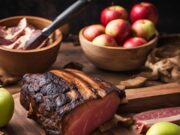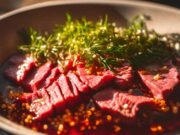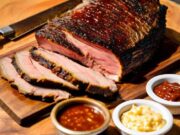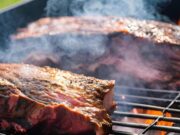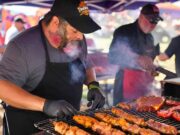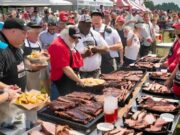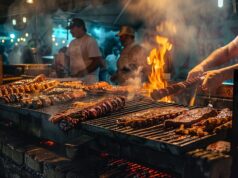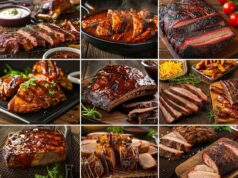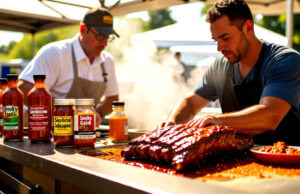A Journey Through Time: The Evolution of American BBQ
Buckle up for a flavorful journey through time as we explore the evolution of American BBQ. Tracing its roots back to the Caribbean, our story starts with Spanish explorers and the indigenous Taino method of slow-roasting meat over an indirect flame, known as “barbacoa.” As this technique traveled north, it was adapted and refined by native tribes and African slaves, forming the foundation of what we know today as classic Southern barbecue. This history is not just about food, it’s a tapestry of cultural influences and regional variations, from the vinegar-soaked traditions of North Carolina to the sweet and spicy styles of Kansas City. So, let’s fire up the grill and delve into this savory slice of America’s past.
Key Takeaways:
- American BBQ has its roots in the Caribbean, notably in the Taino method of slow-roasting meat over an indirect flame, known as “barbacoa.”
- African slaves played a significant role in refining this method, introducing slow-roasting techniques and the use of green wood to avoid burning the meat.
- Barbecue, especially pork, became a necessity in the Southern colonies due to the abundance of pigs. This led to the deep-seated tradition of slow cooking pork over a low fire.
- Four main regional styles of barbecue emerged in the United States: Carolina, Texas, Memphis, and Kansas City. Each region’s barbecue style reflects its unique history and cultural influences.
- The evolution of American BBQ was shaped by pivotal moments in the last century, such as the advent of affordable backyard grills in the 1950s and the establishment of the Kansas City Barbecue Society in 1985.
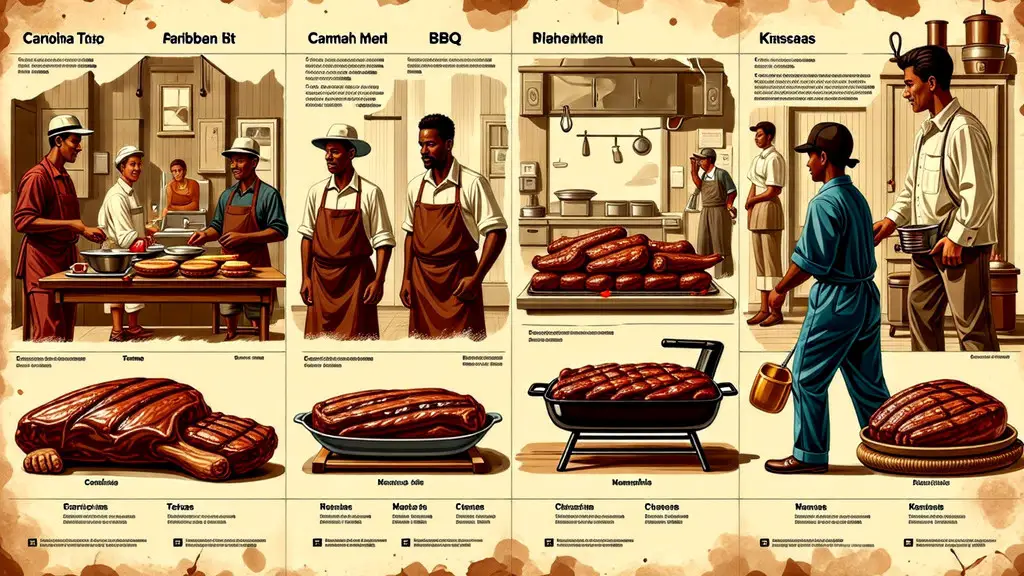
Early African American Influence on Barbecue Styles
The profound influence of African American culture on the evolution of American BBQ cannot be overstated. During the colonial era, African American slaves were often responsible for cooking at large gatherings, including barbecues. Their West African roots introduced techniques such as slow roasting and smoking meats, which became cornerstones of Southern BBQ styles.
The slaves’ barbecue methods often involved the use of green wood and covered pits to smoke the meat slowly, preventing it from burning while infusing it with flavor. These techniques were a necessity given the tough, often undesirable cuts of meat that the slaves were given to cook. Over time, these methods evolved, with each region adding its own unique touches, leading to the wide variety of barbecue styles we see across America today.
In the South, for instance, the dominance of pork as the meat of choice was a direct influence of the African American slaves. They would often be given the less desirable parts of the pig, which they then transformed into flavorful, tender dishes through their expert grilling methods. In addition, the spicy, tangy, and often vinegar-based sauces that are synonymous with Southern BBQ can also be traced back to African influences.
Further north, in areas like Kansas City, the African American influence on barbecue evolved to include a wider variety of meats and a heavier reliance on sweet, smoky sauces. Here, the evolution of American BBQ was also influenced by other cultures, resulting in a fusion of flavors that is uniquely American.
In conclusion, the early African American influence on barbecue styles has played a significant role in shaping the evolution of American BBQ. Their innovative cooking techniques, combined with their ability to transform even the toughest cuts of meat into flavorful dishes, laid the foundation for the rich and diverse barbecue culture we enjoy today. Through a deep understanding of this history, we can appreciate not just the food, but also the stories and traditions that come with each bite.
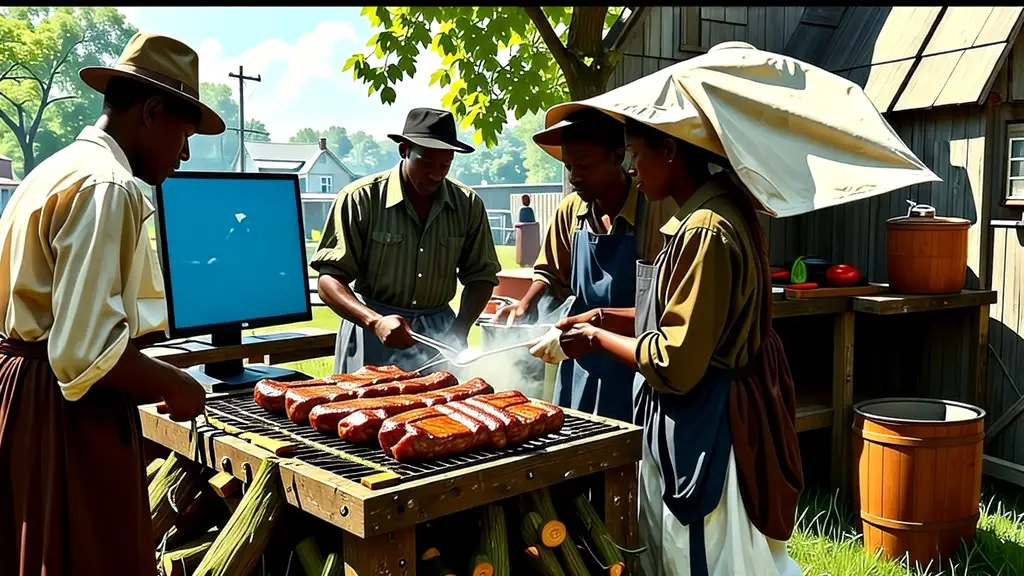
Colonial Southern Barbecue: From Necessity to Delicacy
Reflecting on the journey from necessity to a gourmet treat, the colonial southern barbecue exemplifies the essence of the evolution of American BBQ. With humble beginnings in the Southern colonies, it emerged as a practical solution to the surplus of pigs. Cheaper to rear, pigs were abundant, providing lean meat that required slow cooking to tenderize, thus birthing the slow-cooked pork tradition deeply rooted in Southern culture.
Regional variations started sprouting as British colonists contributed basting techniques and vinegar-based sauces to the mix. A further twist was added by French and German immigrants, who introduced mustard-based sauces, particularly in regions like South Carolina. This amalgamation of cultural influences was pivotal in shaping the distinctive traits of southern barbecue.
Fast forward to contemporary times, and barbecue has become a national obsession, with four primary regional styles captivating taste buds across the United States: Carolina, Texas, Memphis, and Kansas City. Each territory flaunts a unique flair, from North Carolina’s vinegar-based sauces, a tribute to its British colonial roots, to Texas’ adaptation of Carolina techniques to beef, thanks to its German settlers.
Memphis barbecue offers a sweeter experience with its tomato-based sauce, a product of the city’s access to molasses through river trade. Kansas City, heavily influenced by Memphis, boasts sweet and spicy sauces and a diverse selection of meats, making it a barbecue lover’s paradise.
The evolution of American BBQ has been a flavorful rollercoaster, with significant milestones shaping its journey. These include the opening of a barbecue restaurant by Henry Perry, a Memphis-born man, in Kansas City in the early 1900s, which cemented Kansas City as a barbecue hub. The 1950s saw the advent of affordable backyard grills, making barbecue a national pastime. Commercial barbecue sauces like KC Masterpiece, introduced in the 1970s, brought regional flavors to a broader audience. The establishment of the Kansas City Barbecue Society in 1985 fostered a community of pitmasters, further popularizing the culture.
The rich tapestry of American barbecue history is indeed a testament to the cultural melting pot that is the United States. From the early African American influence to the regional variations that make regional barbecue a delightful culinary exploration, the journey from necessity to delicacy is a fascinating one. So, next time you’re savoring barbecue at home or at one of the countless barbecue restaurants, remember the deep historical roots and cultural influences that have shaped this beloved American tradition.
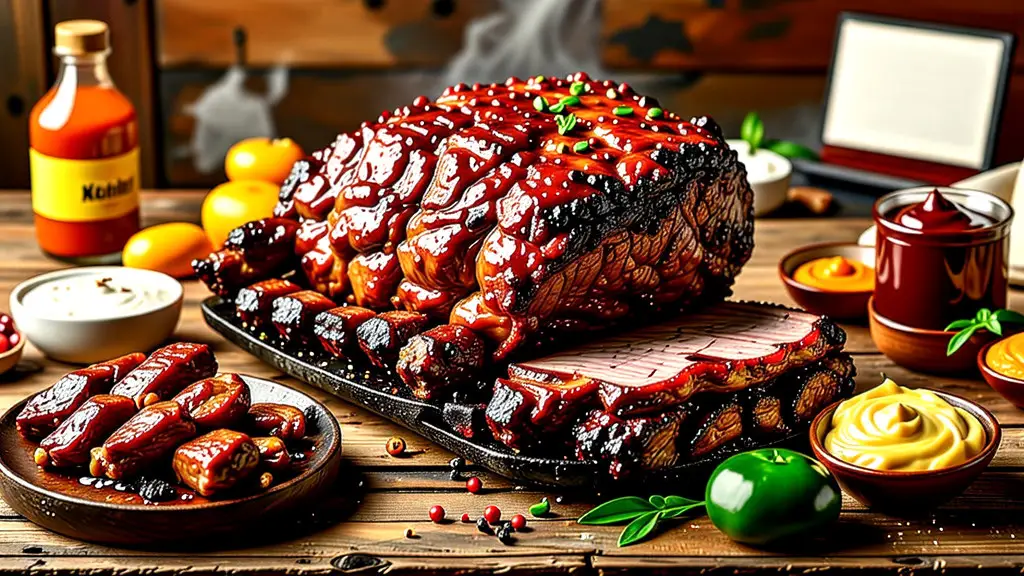
The Rise of Regional BBQ: Kansas City and North Carolina
The evolution of American BBQ has seen a remarkable surge in local styles, particularly in Kansas City and North Carolina. These regions have carved a unique niche in the American BBQ culture, each offering its own distinctive flavors and techniques.
Kansas City BBQ is a melting pot of various styles due to its historical role as a hub for westward expansion. This has resulted in a wide variety of meats used in their BBQ, from pork to beef to chicken. Kansas City BBQ is famous for its thick, sweet, and tangy sauce, a nod to its Memphis influences. The city is also renowned for its burnt ends, the flavorful pieces cut from the ends of a smoked beef or pork brisket.
On the other hand, North Carolina BBQ is steeped in tradition, with a strong influence from its early British settlers. The state is divided into two main styles: Eastern and Lexington. Eastern style BBQ involves smoking a whole hog and serving it with a vinegar-based sauce, staying true to its origins. Lexington or Western style, however, favors pork shoulder or “Boston butt,” served with a tangy, ketchup-based sauce.
These regional styles, born out of cultural influences and historical context, have played a significant role in the evolution of American BBQ. They have added to the richness of this beloved culinary tradition, offering BBQ enthusiasts a flavorful exploration.
| BBQ Style | Key Characteristics | Famous For | Historical Influence |
|---|---|---|---|
| Kansas City | Variety of meats, sweet and tangy sauce | Burnt Ends | Memphis BBQ, Westward Expansion |
| North Carolina Eastern | Whole hog, vinegar-based sauce | Whole Hog BBQ | British Settlers |
| North Carolina Lexington | Pork Shoulder, tangy ketchup-based sauce | Pulled Pork BBQ | German Settlers |
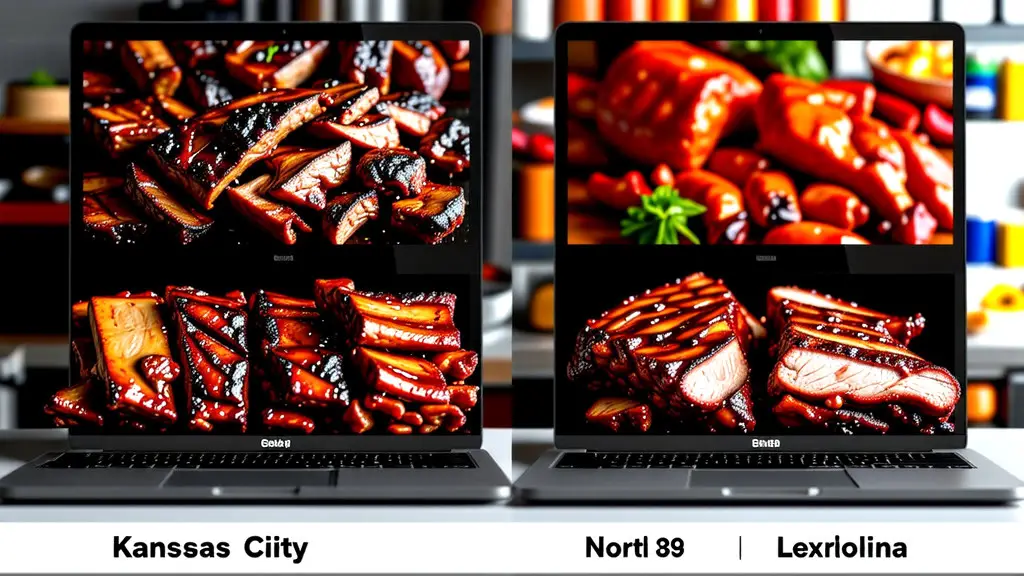
5 Pivotal Moments in the Last Century of American BBQ
Reflecting on the Evolution of American BBQ, key moments from the last 100 years come to mind that have significantly shaped this beloved culinary tradition.
- Henry Perry’s BBQ Venture (Early 1900s): The first milestone occurred when Henry Perry, a Memphis native, brought his BBQ expertise to Kansas City. His restaurant sparked the city’s renowned BBQ style, setting a precedent for future pitmasters.
- Advent of Backyard Grills (1950s): The 1950s saw the rise of affordable backyard grills. This revolutionized the BBQ scene, transforming it from a regional delicacy to a national pastime enjoyed by families across the country.
- Commercial BBQ Sauces (1970s): The 1970s marked the introduction of commercial BBQ sauces like KC Masterpiece. This development broadened the reach of regional BBQ flavors, enabling everyone to savor different BBQ styles at home.
- Kansas City Barbecue Society (1985): The establishment of the Kansas City Barbecue Society in 1985 was a game-changer. It standardized competition BBQ and fostered a community of BBQ enthusiasts and pitmasters.
- Media Influence (2010s): The last decade saw the media playing a significant role in popularizing BBQ. Cooking shows and online content, such as BBQ Critic, brought BBQ culture to a wider audience, encouraging experimentation and diversity in BBQ styles.
These pivotal moments have undoubtedly shaped the Evolution of American BBQ over the last century, contributing to the rich tapestry of regional styles and flavors we relish today.

Conclusion
Traversing the journey of American BBQ, it’s clear that its evolution is a rich tapestry of cultural influences, regional adaptations, and historical developments. From the early African American influence on barbecue styles, the inception of colonial Southern barbecue, to the rise of regional BBQ in Kansas City and North Carolina, each phase is a testament to the resilience and creativity of the American spirit.
The last century, in particular, has seen pivotal moments that have not only reshaped barbecue traditions but also democratized them, making barbecue a quintessential part of American food culture. These milestones, coupled with the continuous evolution of techniques and flavors, ensure that the future of American BBQ remains as vibrant and diverse as its history.
In essence, American BBQ is more than just a method of cooking. It’s a historical journey, a cultural phenomenon, and an enduring symbol of community spirit. It’s a testament to America’s multicultural heritage and its capacity to transform simple necessities into iconic delicacies. So next time you savor that smoky, tender BBQ, remember, you’re not just having a meal; you’re partaking in a rich, ever-evolving tradition.
FAQ
- What is the origin of barbecue in America? The roots of barbecue in America trace back to the Caribbean, where Spanish explorers learned the Taino method of cooking meat over indirect flame, referred to as “barbacoa.” Indigenous tribes and African slaves in North America further refined this technique, with African slaves using slow-roasting methods from West Africa and cooking with green wood to avoid burning the meat.
- How did barbecue evolve in the Southern colonies? In the Southern colonies, barbecue became a necessity due to the abundance of pigs, which were inexpensive and easy to raise. The pigs’ leaner meat required slow cooking to tenderize, leading to the deep-rooted Southern culture of slow-cooking pork over a low fire. British colonists contributed basting techniques and vinegar-based sauces, while French and German immigrants introduced mustard-based sauces.
- What are the four main regional styles of barbecue in the United States? The four primary regional styles of barbecue in the United States are Carolina, Texas, Memphis, and Kansas City. North Carolina’s barbecue is known for vinegar-based sauces, Texas has a distinct beef barbecue influenced by German settlers, Memphis is famous for its sweet, tomato-based sauce, and Kansas City is known for a variety of meats served with sweet and spicy sauces.
- Who is Henry Perry and why is he significant to the history of American BBQ? Henry Perry, a man from Memphis, is a significant figure in the history of American BBQ as he opened a barbecue restaurant in Kansas City in the early 1900s. This establishment helped solidify Kansas City’s legacy in the barbecue scene.
- What were the crucial moments in the evolution of American BBQ in the last century? The pivotal moments include the popularization of backyard grills in the 1950s, the introduction of commercial barbecue sauces like KC Masterpiece in the 1970s, the establishment of the Kansas City Barbecue Society in 1985, and the surge in media representation of barbecue culture in the 2010s. These phases played a significant role in molding the barbecue culture we know today.



